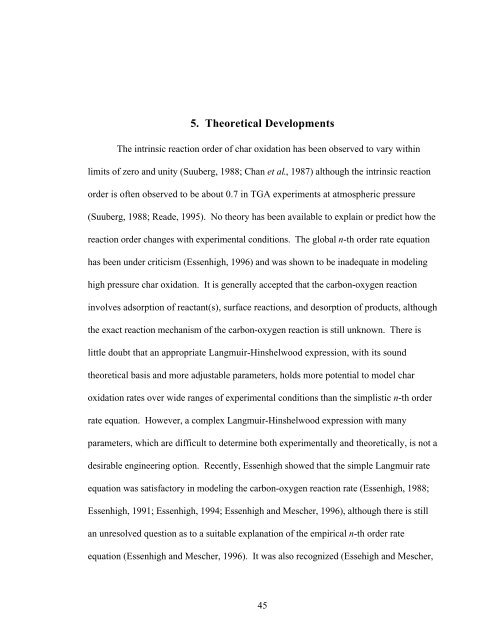MODELING CHAR OXIDATION AS A FUNCTION OF PRESSURE ...
MODELING CHAR OXIDATION AS A FUNCTION OF PRESSURE ...
MODELING CHAR OXIDATION AS A FUNCTION OF PRESSURE ...
Create successful ePaper yourself
Turn your PDF publications into a flip-book with our unique Google optimized e-Paper software.
5. Theoretical Developments<br />
The intrinsic reaction order of char oxidation has been observed to vary within<br />
limits of zero and unity (Suuberg, 1988; Chan et al., 1987) although the intrinsic reaction<br />
order is often observed to be about 0.7 in TGA experiments at atmospheric pressure<br />
(Suuberg, 1988; Reade, 1995). No theory has been available to explain or predict how the<br />
reaction order changes with experimental conditions. The global n-th order rate equation<br />
has been under criticism (Essenhigh, 1996) and was shown to be inadequate in modeling<br />
high pressure char oxidation. It is generally accepted that the carbon-oxygen reaction<br />
involves adsorption of reactant(s), surface reactions, and desorption of products, although<br />
the exact reaction mechanism of the carbon-oxygen reaction is still unknown. There is<br />
little doubt that an appropriate Langmuir-Hinshelwood expression, with its sound<br />
theoretical basis and more adjustable parameters, holds more potential to model char<br />
oxidation rates over wide ranges of experimental conditions than the simplistic n-th order<br />
rate equation. However, a complex Langmuir-Hinshelwood expression with many<br />
parameters, which are difficult to determine both experimentally and theoretically, is not a<br />
desirable engineering option. Recently, Essenhigh showed that the simple Langmuir rate<br />
equation was satisfactory in modeling the carbon-oxygen reaction rate (Essenhigh, 1988;<br />
Essenhigh, 1991; Essenhigh, 1994; Essenhigh and Mescher, 1996), although there is still<br />
an unresolved question as to a suitable explanation of the empirical n-th order rate<br />
equation (Essenhigh and Mescher, 1996). It was also recognized (Essehigh and Mescher,<br />
45
















